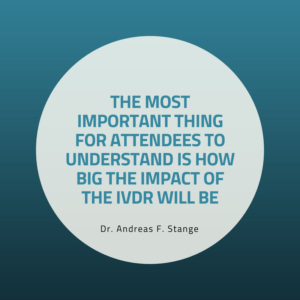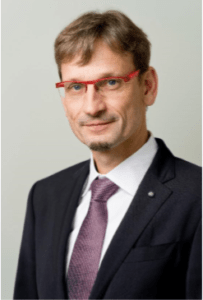Dr. Andreas F. Stange is the Vice President MHS global IVD with TÜV SÜD. He will be presenting at the upcoming EU IVDR Transition & Implementation Workshop Intensive on July 13 in Alexandria, VA. Looking to better understand how to navigate the IVDR transition timeline? Read more below.
Please provide a brief overview of what your day-to-day operations look like in your role as Vice President MHS global IVD at TÜV SÜD.
My primary task is to take care of worldwide strategic business development concerning the IVD business of TÜV SÜD’s medical health services. I work with our headquarters in Munich and the different regions such as the United States, China, Korea and Japan to coordinate resource build-up, training and education. One very important task is to ensure that we get our designation for the IVDR. This requires good coordination not only within our own organization but also with external stakeholders. We are preparing for the MDR accreditation at the same time, this process is challenging, but the first steps have been successfully taken.
What are some of the IVDR related initiatives/objectives that TÜV SÜD has on the horizon for the remainder of 2018?
We’ve been preparing and working towards the IVDR for 2-3 years already. One area is to update our quality management systems and procedures in order to match the requirements of the regulation. Another TÜV SÜD initiative is to grow the organization to keep up with the future workload, so we’re currently hiring and coordinating the education of new employees. Additionally, we’re also in the midst of the designation process. We have submitted our application of designation at the earliest date possible (November 26, 2017). Our submitted documents have been reviewed by the Competent Authorities and the Commission, and we are now scheduling our on-site audit which will be conducted by the German Competent Authority, as well as other European Competent Authorities together with the Commission. We hope this will happen smoothly, but we may have to correct some non-conformities, as it is most likely due to the very much tightened requirements of the new regulation for Notified Bodies. In addition we’re engaging ourselves in educating and explaining the upcoming regulation to our clients to ensure that they understand what is upcoming and can prepare adequately.

How would you advise an organization navigating the IVDR transition timeline? Would you have any recommendations for companies just beginning the transition?
Companies need to be aware of what is happening in the future throughout the organization. The Regulation brings huge changes for IVD manufacturers who want to put their devices on the European market, and organizations need to understand how they can best navigate through the transition period. I would recommend organizations to review their product portfolio to see which products they need to begin focusing on. A gap analysis of the quality system and the technical documentation for each device against the requirements of the IVDR has to be done as soon as possible, and a schedule how to close the identified gaps implemented. If the company manufactures devices already certified by a Notified Body under the IVDD, the company is well advised to ensure meeting the conditions for the “extended transition period” for these devices by re-certification according to IVDD in time. The company should get in touch with a Notified Body to decide how they can work together to perform the conformity assessment. I’d advise to start the activities as soon as possible to be fully prepared for the upcoming changes. The resource needs will then become very clear to the organizations—both financial as well as human resources required to manage all the challenges.
What is something you believe is most important for attendees to walk away from the workshop knowing?
The most important thing for attendees to understand is how big the impact of the IVDR will be. They should try to align their organization towards these changes, and communicate the impact within their own organization so that they are not alone and so the organization can support these adjustments and changes. They’re also welcome to engage TÜV SÜD to help explain the upcoming changes and figure out how they can work together in order to prepare for the transition.
As an industry leader, why do you think people should attend this workshop?
Obviously, it’s very important for manufacturers who are placing products in the European Union market. But also firms who are working side by side with diagnostic firms should understand the impact of the IVDR with regard to companion diagnostics, we have the manufacturers of medicinal products who should also be aware of the regulatory requirements which are pertaining to the diagnostic aspects.
Personally, I enjoy interacting with clients and discussing how we can work with manufacturers and stakeholders to manage these challenges around the IVDR. Having a practical discussion on how we can collaborate to manage and solve challenges is important. I am very much looking forward to the event.
 Dr. Andreas F. Stange is a vice president for the Medical and Health Services group at TÜV SÜD Product Service. He serves as the global responsible for the In-vitro Diagnostic Devices business line. Dr. Stange joined TÜV SÜD in 2001 as medical device expert and had various positions since then in the group. Before taking the current position in March 2017, he was President & CEO of TÜV SÜD in Japan. Join us for the EU IVDR Transition and Implementation Workshop Intensive on July 13 in Alexandria, VA and be sure to hear Dr. Stange present the keynote address, “IVDR: Important Timelines & Their Impact On Economic Operators.” Click here to register today!
Dr. Andreas F. Stange is a vice president for the Medical and Health Services group at TÜV SÜD Product Service. He serves as the global responsible for the In-vitro Diagnostic Devices business line. Dr. Stange joined TÜV SÜD in 2001 as medical device expert and had various positions since then in the group. Before taking the current position in March 2017, he was President & CEO of TÜV SÜD in Japan. Join us for the EU IVDR Transition and Implementation Workshop Intensive on July 13 in Alexandria, VA and be sure to hear Dr. Stange present the keynote address, “IVDR: Important Timelines & Their Impact On Economic Operators.” Click here to register today!





